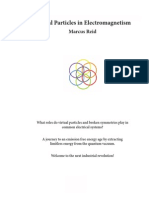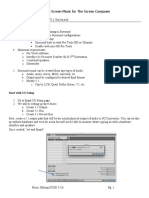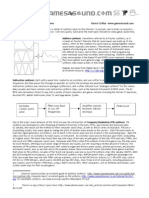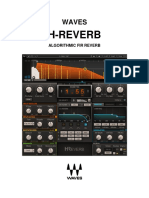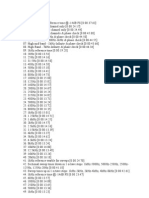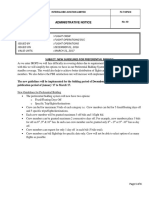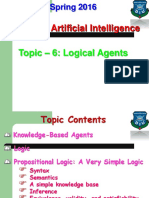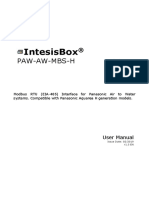Mid Side Processing
Uploaded by
Novevacche DemoncowsMid Side Processing
Uploaded by
Novevacche DemoncowsMid / Side Processing for Enhanced Stereo Effects
By Guillaume Jeulin
Blue Cat Audio
http://www.bluecataudio.com
Concept Origin: Mid/Side Recording
Mid/Side recording is a quite famous recording technique that is preferred in some cases to
the traditional Left/Right recording. Looking for mid side recording in Google will give ou
man tutorials a!out this technique. "e won#t discuss it in details here$ m goal is to
e%plain how Mid/Side processing works and where it comes from.
&nwa$ as a result of our recording ou end'up with the Mid / Side (M/S) channels
instead of classic Left / Right (L/R) channels in our audio stream. *he Mid channel is also
often called Mono and Side Stereo (that#s nice$ it#s the same letters+), the Mid channel
contains the signal that is in the center of the stereo mi%$ and the Side channel contains
the rest (everthing that is on the sides of the mi%),
(*he triangles a!ove represent the listener#s head)
From Mid/Side Recording to Processing
*he relationship !etween L/R and M/S channel can !e computed so that ou can transform
an Mid/Side recording to standard listen a!le Left/Right stereo stream. *he reverse
operation is also possi!le$ which means that ou can artificiall separate Mid/Side
information from our usual L/R stereo tracks. *hat#s what is done ! our Mid/Side
processing plug'ins.
Mid / Side -rocessing for &dvanced Stereo .ffects
/opright(c) Guillaume 0eulin 1223'1224
L R
S S
M
Left / Right Stereo Mid / Side Stereo
-rocessing separatel the Mid/Side channels instead of Left/Right channels makes stereo
widening ver eas, ou control the wa ou appl our effect on the Mono (Mid) and
Stereo (Side) parts of the sound. *he simplest mid side processing ou can do is modif the
gain on Mid/Side to enhance or reduce the stereo impression of our sound, !oost Mid and
/ut Sides will make our sound more 5Mono# and do it the other wa will widen our sound,
it will sound more 5Stereo#.
*his principle can !e applied to man effects. 6or e%ample using a 5widening# .quali7er such
as 8lue /at#s "idening -arametr#.9 or 8lue /at#s "idening Lin .9 ena!les ou to choose
which frequencies ou want !oost/cut on the sides or on the center of the stereo field. Let#s
sa ou want more !ass in the middle$ and more tre!le on the sides$ :ust push 1 sliders+
Going further: choosing the Virtual Center position
Mid/Side processing can !e further enhanced with the choice of the virtual center of the
Mid/Side channels. "hat does this actuall mean; <t means that ou can decide where the
virtual Mid /hannel is in the stereo field when doing our M/S channels separation,
=ou can see a!ove that when ou move the virtual center >22? to the left or >22? to the
right ou end up with the traditional L/R stereo channels.
<n the end what happens is that ou can e%actl choose where our effect takes place. &s
e%plained !efore ou are a!le to process separatel Mid and Side channels. Since ou can
now choose where the are in the stereo field$ ou can choose where the processing takes
place.
Mid / Side -rocessing for &dvanced Stereo .ffects
/opright(c) Guillaume 0eulin 1223'1224
S
S
M
Virtual Center is a bit
on the left
S S
M
Virtual Center is
centered
S M
Virtual Center is
100% on the left
S S
Pure Stereo (M=0)
M
Pure Mono (S=0)
Left
Right
Mid
Side
Left
Right
Process rearrange
Example, 8oosting 8ass for the Mid /hannel with a 13? left virtual center position will
!oost the !ass slightl on the Left onl$ and cutting tre!le on the Side will cut it on the
right$ and on the e%treme left of the stereo field.
*hat#s a ver powerful tool to choose where ou want to appl our effect and thus
enhance the stereo rendering of our sounds. <t can !e applied to a final mi% in a su!tle
wa to appl the effect in a specific place$ and also on a track for a given instrument to
change the wa it occupies the stereo filed$ without panning it completel.
Conclusion
Mid/Side processing is an eas'to'use technique to enhance the stereo perception of an
audio track$ and choosing the virtual center position then lets ou enter the world of
advanced audio effect positioning in the stereo field.
6or more information a!out 8lue /at &udio@s Mid/Side effects$ please visit our we!site,
http,//www.!luecataudio.com/. 6ree demos are availa!le.
Mid / Side -rocessing for &dvanced Stereo .ffects
/opright(c) Guillaume 0eulin 1223'1224
Cut !reble
Cut !reble
"oost "ass
"oosting Mid bass and cutting Side
treble #ith center $%% on the left
You might also like
- behind-the-glass-top-record-producers-tell-how-they-craft-the-hits-volume-1No ratings yetbehind-the-glass-top-record-producers-tell-how-they-craft-the-hits-volume-129 pages
- Capstone Presentation: Telecom Churn Study100% (3)Capstone Presentation: Telecom Churn Study19 pages
- Virtual Particles in Electromagnetism Marcus ReidNo ratings yetVirtual Particles in Electromagnetism Marcus Reid28 pages
- Mixer Basics For Beginners: The Signal PathNo ratings yetMixer Basics For Beginners: The Signal Path7 pages
- Valley People Dyna-Mite Original Hardware ManualNo ratings yetValley People Dyna-Mite Original Hardware Manual18 pages
- XXXX XXXX 6322: XXXX XXXX 6322 XXXX XXXX 6322No ratings yetXXXX XXXX 6322: XXXX XXXX 6322 XXXX XXXX 63221 page
- How To Get A Quality Audio Recording: So, You Want to Be An Audio EngineerFrom EverandHow To Get A Quality Audio Recording: So, You Want to Be An Audio EngineerNo ratings yet
- 7 Stereo Miking Techniques You Should Try - SweetwaterNo ratings yet7 Stereo Miking Techniques You Should Try - Sweetwater6 pages
- The Audio Console: by Jim Kaiser With Additions by Dave ToughNo ratings yetThe Audio Console: by Jim Kaiser With Additions by Dave Tough13 pages
- Argosy 50V2-R V Series Universal Workstation Pro Audio LANo ratings yetArgosy 50V2-R V Series Universal Workstation Pro Audio LA1 page
- Download full (Ebook) Producing Great Sound for Film and Video : Expert Tips from Preproduction to Final Mix by Jay Rose ISBN 9780240809700, 9780240810508, 9780415722070, 9781136061059, 9781136061097, 9781771883382, 024080970X, 0240810503, 0415722071 ebook all chapters100% (1)Download full (Ebook) Producing Great Sound for Film and Video : Expert Tips from Preproduction to Final Mix by Jay Rose ISBN 9780240809700, 9780240810508, 9780415722070, 9781136061059, 9781136061097, 9781771883382, 024080970X, 0240810503, 0415722071 ebook all chapters67 pages
- Live Sound Reinforcement, Bestseller Edition DVD Tutorial) - Free Books SourceNo ratings yetLive Sound Reinforcement, Bestseller Edition DVD Tutorial) - Free Books Source9 pages
- Modern Recording Techniques, Huber, Robert E. Runstein ReverbNo ratings yetModern Recording Techniques, Huber, Robert E. Runstein Reverb3 pages
- Additive Synthesis (Sometimes Referred To As Fourier Synthesis, As ItNo ratings yetAdditive Synthesis (Sometimes Referred To As Fourier Synthesis, As It2 pages
- Subwoofer Delay Taper (Update 1) - Bob McCarthyNo ratings yetSubwoofer Delay Taper (Update 1) - Bob McCarthy8 pages
- Acoustic Treatment in A Sound Control RoomNo ratings yetAcoustic Treatment in A Sound Control Room18 pages
- The Official Publication of The Yamaha Users Group: January 1989No ratings yetThe Official Publication of The Yamaha Users Group: January 198920 pages
- Music Theory - Hopkins, Gary - Improve Your Songwriting PDF100% (1)Music Theory - Hopkins, Gary - Improve Your Songwriting PDF2 pages
- Audio Bandwidth Extension: Application of Psychoacoustics, Signal Processing and Loudspeaker DesignFrom EverandAudio Bandwidth Extension: Application of Psychoacoustics, Signal Processing and Loudspeaker DesignNo ratings yet
- Experiments To Proof The Evidence of Scalar Waves Tests With A Tesla Reproduction by Prof. Konstantin Meyl100% (2)Experiments To Proof The Evidence of Scalar Waves Tests With A Tesla Reproduction by Prof. Konstantin Meyl14 pages
- My Tesla's Radiant Energy Collector (Open Project)100% (1)My Tesla's Radiant Energy Collector (Open Project)10 pages
- The Classic Tesla Coil A Dual-Tuned Resonant TransformerNo ratings yetThe Classic Tesla Coil A Dual-Tuned Resonant Transformer3 pages
- The Double Helix Theory of The Magnetic FieldNo ratings yetThe Double Helix Theory of The Magnetic Field21 pages
- Isilon Solve Generator: Topic SelectionsNo ratings yetIsilon Solve Generator: Topic Selections18 pages
- Azure Reference Architectures - Microsoft DocsNo ratings yetAzure Reference Architectures - Microsoft Docs5 pages
- Term Project: Simulation of Different Protocols Using Cnet Network SimulatorNo ratings yetTerm Project: Simulation of Different Protocols Using Cnet Network Simulator14 pages
- Software AG SLG EDU Price List - Software Licenses - PerpetualNo ratings yetSoftware AG SLG EDU Price List - Software Licenses - Perpetual2 pages
- Manual PAW-AW-MBS-H User Manual v1.2 r1.3 enNo ratings yetManual PAW-AW-MBS-H User Manual v1.2 r1.3 en21 pages
- Transit Capacity & Quality of Service Manual, Third Edition: Multimodal Transit LOS Computational EngineNo ratings yetTransit Capacity & Quality of Service Manual, Third Edition: Multimodal Transit LOS Computational Engine13 pages
- 12 GB Operating Instructions Uluf ModelsNo ratings yet12 GB Operating Instructions Uluf Models27 pages
- Manual. MOVIDRIVE MDX61B Sensor Based Positioning Via Bus Application. Edition 01 - 2005 FA362000 11313528 - ENNo ratings yetManual. MOVIDRIVE MDX61B Sensor Based Positioning Via Bus Application. Edition 01 - 2005 FA362000 11313528 - EN84 pages




